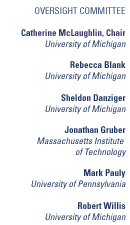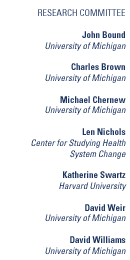|



The University of Michigan
555 South Forest Street
Third Floor
Ann Arbor, MI 48104-2531
T 734-936-9842
F 734-998-6341
/
|
 |
 |
Q&A with
Alan Monheit, Ph.D.
Alan Monheit, Professor in the School of Public Health at the University of Medicine and Dentistry of New Jersey, has spent his career examining the relationship between employment and health insurance coverage and other health care issues. Former director of the Division of Social and Economic Research at the U.S. Agency for Healthcare Research and Quality, Monheit recently co-authored the paper, "Health Insurance Enrollment Decisions: Understanding the Role of Preferences for Coverage."
Q: What has research show about why some people don't take up offers of health insurance?
A: There isn't a lot of empirical research. Most of it generally looks at the influence of out-of-pocket premium costs both in the individual market and the employment market. Out-of-pocket cost is a concern. With regard to public coverage, there was speculation that eligibles did not enroll largely because of a lack of information about the programs. Some speculate that stigma might be an issue creating disincentives for enrollment.
Q: What does your work show about the reasons people are uninsured?
A: We estimate about one-fifth of those who are uninsured all year in 2000 believe they are healthy enough and don't need coverage. In contrast, only seven percent of those insured all year report such weak preferences for coverage. Other measures of weak preferences for health insurance show about a third of persons uninsured throughout 2000 report 'health insurance is not worth the cost,' while roughly 30 percent of persons uninsured all year consider themselves to be 'risk takers.' In contrast, only a fifth of persons insured all year report such preferences. Thus we have some empirical sense that these attitudes regarding health status, the cost of health insurance, or risk-taking behavior are correlated with insurance status.
Q: Any sense of how many of these folks want insurance but it's just too expensive versus those who don't believe they need and therefore not worth the cost?
A: Yes. With regards to the attitude toward the cost of health insurance and attitudes regarding risk-taking behavior, they resemble persons who are uninsured all year. With regard to those who respond to "I'm healthy enough and I don't need coverage…" they are somewhere in the middle. The proportion reporting weak preferences is about 10%, which is about right in the middle between those who are insured all year and those who are uninsured all year.
We haven't measured affordability directly. We have some data suggesting that individuals with weak preferences for coverage tend to be younger and they tend to have lower educational attainment, and tend to fall in low- or middle-income groups. We certainly are cognizant that affordability may be an issue for some individuals who report
weak preferences for coverage.
Q: So what kinds of individuals are less likely to take up offers of insurance?
A: Low-wage workers, workers with low-educational attainment, young adults, Hispanic workers, the self-employed and certainly workers in small firms. Education and income are the most prominent factors. It's real on the education, income side where this is most prominent. Workers who take up offers of coverage are higher-wage workers and somewhat better educated. Even policy initiatives that subsidize the cost of coverage or make it relatively costless to individuals there has been low enrollment responses. That's the motivation for our paper.
Q: How does your work in this paper give us a better understanding of why some people don't take up offers of health insurance and why some don't?
A: Our paper suggests that some workers will prefer jobs that don't offer health insurance because they may prefer wage income instead. So they seek out jobs that may provide greater wage income in place of health insurance. Those people value wage income more and, given their economic circumstances, find wage income to be more attractive. There is greater certainty with the receipt of wage income in terms of goods and services that you can consume. Health insurance yields an uncertain flow of benefits. There's more uncertainty as to whether you will need to use health insurance.
Q: How does your paper give us a better understanding of so-called job sorting?
A: In two ways. First, it showed that preferences for health insurance are an independent factor in the likelihood of taking up a job that offers health insurance coverage. This paper demonstrates that preferences for health insurance, apart from such individual characteristics as age, education and race/ethnicity, play a role in whether you obtain a job offer with health insurance. Secondly, it builds on earlier work that just looked at single workers. Our paper demonstrates this effect for married couples as well. It's one way of showing that directly measured preferences for health insurance play a role in predicting the probability that a worker will obtain a job with health insurance, apart from particular characteristics of a worker.
Q: How does the lack of insight in this area muddy policy efforts?
A: One focus, for example, in debates over extending health insurance is whether to do it in a voluntary system or mandate health insurance benefits. If workers differ in their valuation of health insurance, a mandate - such as an employer mandate or state mandated benefits - is going to make those workers who have weaker preferences for health insurance and stronger preferences for wages worse off. As a result, a mandate may not be efficient policy. Meanwhile, a voluntary system - such as extending tax credits or small group and individual insurance reforms - alone may not be successful. We argue for using other factors, such as educational efforts, that would not only inform people about the availability of a program, but provide people with basic information about the value of health insurance.
Q: Why is understanding individuals' valuation of health insurance important when policymakers debate health insurance expansions?
A: Strategies to encourage voluntary participation in private and public health insurance assume that coverage can be expanded by creating appropriate incentives to make coverage more affordable (through subsidies or constraints on the range of premiums) and accessible. This presupposes that individuals have strong preferences for coverage and will respond to these incentives and enhanced opportunities to enroll in coverage.
However, if some individuals have weak preferences for coverage and place a low value on health insurance, they may not respond to such efforts to encourage voluntary
participation. As a result, such voluntary efforts will fall short of their desired goals. Thus voluntary approaches may need to be accompanied by educational efforts that provide individuals with more generic information on the purpose of health insurance, its attendant costs, and its likely impact on improving access to services and the quality and continuity of care. Alternatively, approaches to mandate health insurance may make individuals with weak preferences for coverage who are now compelled to enroll worse off. Consequently, premium or income subsidies may be required to offset the loss in welfare associated with the required premium costs imposed on these individuals and families.
Q: What should policymakers take away from this research?
A: Two things: First, weak preferences for coverage could, in fact, reflect problems of affordability. Secondly, the policy mechanism used should take into account the role of individuals' preferences for health insurance. Mandated approaches may in fact have unintended consequences by reducing the welfare of individuals who don't value health insurance. On the other hand, voluntary approaches may require creating financial incentives and additional information on the value of health insurance to individuals.
Q: Tell me what your findings suggest about the need for an education campaign about the value of health insurance?
A: We think that education targeted at certain uninsured groups who appear to exhibit weak preferences for coverage. It's education about the merits of health insurance. It's not just simply telling people about the presence of a new program, but it's more generic information about what is the purpose of health insurance. It's financial security, it's security against high costs/low probability events. There are out-of-pocket costs associated with health insurance in part to make sure people use their coverage prudently and that another value of health insurance is that it improves the timely access to health care services and it is associated with better quality and more continuity in the quality of their care. We would argue that stressing an occasional effort along with any kind of program that would try to entice people via subsidies, whether it be tax credits, we would hope and think that would be of some value.
Q: What's the next step in research to build on this?
A: The next logical step is trying to figure out how much you would have to compensate individuals in order to overcome their weak preferences for coverage. We've come up with some preliminary estimates that suggest the kind of subsidy necessary for individuals to overcome the loss in welfare that is associated with weak preferences for coverage. That's a logical extension.
Back to top 
Funded by The Robert Wood Johnson Foundation, ERIU is
a five-year program shedding new light on the causes and consequences
of
lack of coverage, and the crucial role that health insurance plays in
shaping the U.S. labor market. The Foundation does not endorse the findings
of this or other independent research projects.
|
